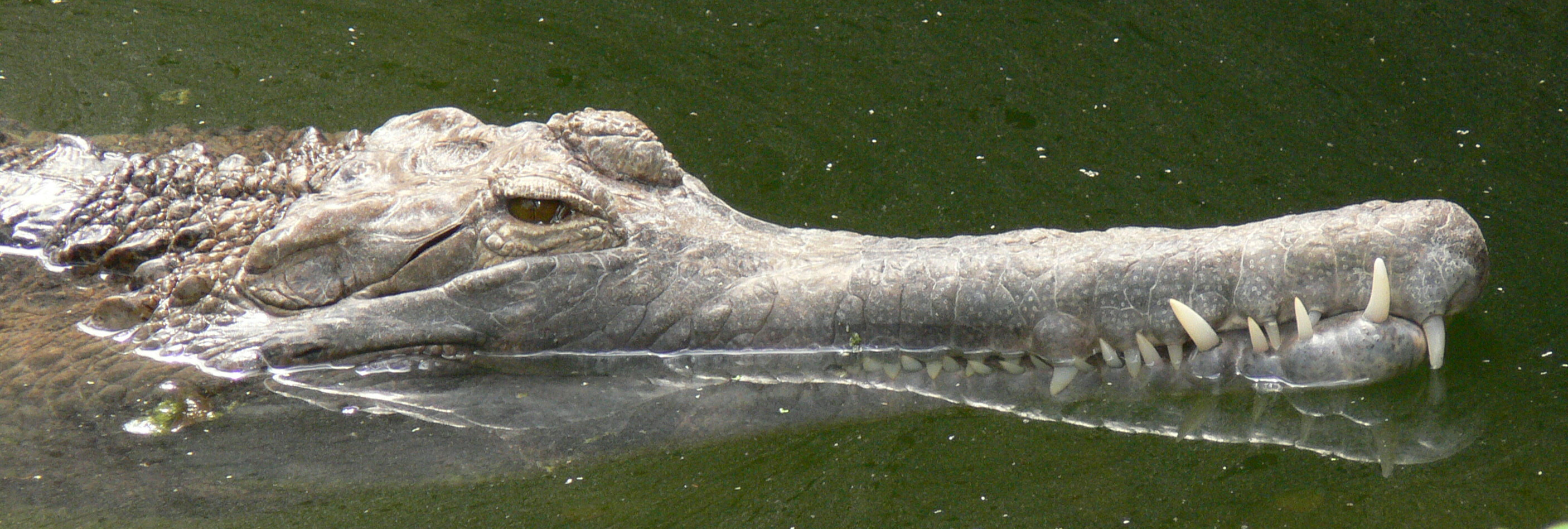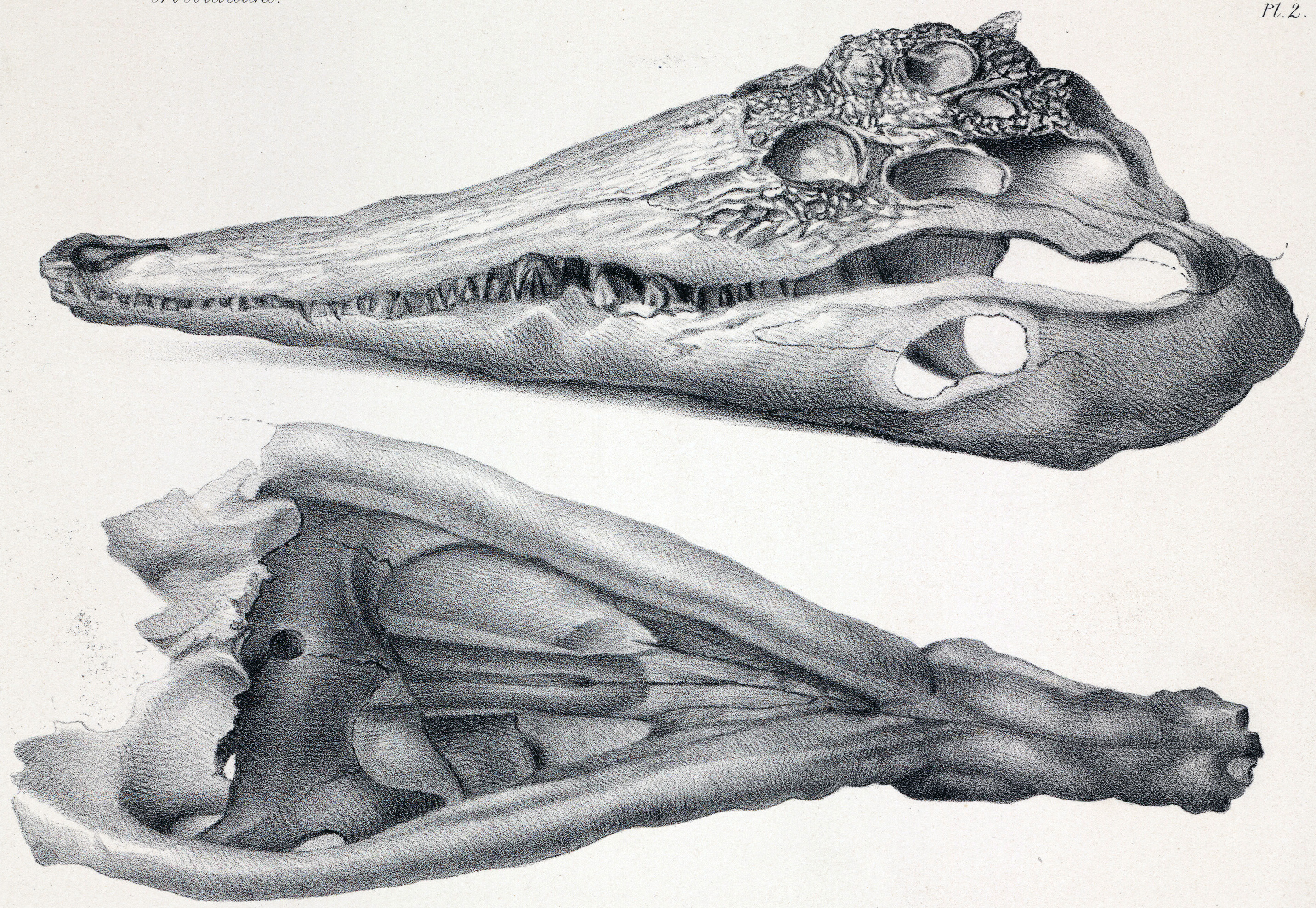|
Gavialidae
Gavialidae is a family of large semiaquatic crocodilians with elongated, narrow snouts. Gavialidae consists of two living species, the gharial (''Gavialis gangeticus'') and the false gharial (''Tomistoma schlegelii''), both occurring in Asia. Many extinct members are known from a broader range, including the recently extinct '' Hanyusuchus''. Gavialids are generally regarded as lacking the jaw strength to capture the large mammalian prey favoured by crocodiles and alligators of similar size so their thin snout is best used to catch fish, however the false gharial has been found to have a generalist diet with mature adults preying upon larger vertebrates, such as ungulates. Taxonomy The family Gavialidae was proposed by Arthur Adams in 1854 for reptiles with a very long and slender muzzle, webbed feet and nearly equal teeth. It is currently recognized as a crown group, meaning that it only includes the last common ancestor of all extant (living) gavialids (the gharial and false g ... [...More Info...] [...Related Items...] OR: [Wikipedia] [Google] [Baidu] |
Gharial
The gharial (''Gavialis gangeticus''), also known as gavial or fish-eating crocodile, is a crocodilian in the family (biology), family Gavialidae and among the longest of all living crocodilians. Mature females are long, and males . Adult males have a distinct boss at the end of the snout, which resembles an earthenware pot known as a ''ghara'', hence the name "gharial". The gharial is well adapted to catching fish because of its long, narrow snout and 110 sharp, interlocking teeth. The gharial probably evolved in the northern Indian subcontinent. Fossil gharial remains were excavated in Pliocene deposits in the Sivalik Hills and the Narmada River valley. It currently inhabits rivers in the plains of the northern part of the Indian subcontinent. It is the most thoroughly aquatic crocodilian, and leaves the water only for basking and building nests on moist sandbanks. Adults mate at the end of the cold season. Females congregate in spring to dig nests, in which they lay 20–95 e ... [...More Info...] [...Related Items...] OR: [Wikipedia] [Google] [Baidu] |
False Gharial
The false gharial (''Tomistoma schlegelii''), also known by the names Malayan gharial, Sunda gharial and tomistoma is a freshwater crocodilian of the Family (biology), family Gavialidae native to Peninsular Malaysia, Borneo, Sumatra and Java. It is listed as Endangered species, Endangered on the IUCN Red List, as the global population is estimated at around 2,500 to 10,000 mature individuals. The Specific name (zoology), species name ''schlegelii'' honors Hermann Schlegel. Characteristics The false gharial is dark reddish-brown above with dark brown or black spots and cross-bands on the back and tail. Ventrals are grayish-white, with some lateral dark mottling. Juveniles are mottled with black on the sides of the jaws, body, and tail. The smooth and unornamented snout is extremely long and slender, parallel sided, with a length of 3.0 to 3.5 times the width at the base. All teeth are long and needle-like, interlocking on the insides of the jaws, and are individually socketed. ... [...More Info...] [...Related Items...] OR: [Wikipedia] [Google] [Baidu] |
Gavialoidea
Gavialoidea is one of three superfamily (zoology), superfamilies of crocodylians, the other two being Alligatoroidea and Crocodyloidea. Although many extinct species are known, only the gharial ''Gavialis gangeticus'' and the false gharial ''Tomistoma schlegelii'' are alive today, with ''Hanyusuchus'' having become extinct in the last few centuries. Extinct South American gavialoids likely Dispersal (ecology), dispersed in the mid Tertiary period, Tertiary from Africa and Asia. Fossil remains of the Puerto Rican gavialoid ''Aktiogavialis puertorisensis'' were discovered in a cave located in San Sebastián, Puerto Rico and dated to the Oligocene. This individual is thought to have crossed the Atlantic coming from Africa, indicating that this species was able to withstand saltwater. Classification Gavialoidea is Cladistics, cladistically defined as ''Gavialis gangeticus'' (the gharial) and all crocodylians closer to it than to ''Alligator mississippiensis'' (the American alligator) ... [...More Info...] [...Related Items...] OR: [Wikipedia] [Google] [Baidu] |
Gryposuchinae
Gryposuchinae is an extinct subfamily of gavialid crocodylians. Gryposuchines lived mainly in the Miocene of South America. However, '' "Ikanogavialis" papuensis'' may have survived more recently, into the Late Pleistocene/Holocene. Most were long-snouted coastal forms. The group was named in 2007 and includes genera such as ''Gryposuchus'' and ''Aktiogavialis'', although a 2018 study indicates that the group might be paraphyletic and rather an evolutionary grade towards the gharial. Description Gryposuchines had long, narrow snouts and protruding eye sockets. One distinguishing feature of the group is the lack of a large exposure of the prootic bone around the trigeminal foramen, a hole in the side of the braincase wall. Classification Gryposuchinae was named in 2007 as a subfamily of closely related gavialid crocodilians. It was cladistically defined as a stem-based taxon including ''Gryposuchus jessei'' and all crocodilians more closely related to it than to ''Gavialis gan ... [...More Info...] [...Related Items...] OR: [Wikipedia] [Google] [Baidu] |
Tomistominae
Tomistominae is a subfamily of crocodylians that includes one living species, the false gharial. Many more extinct species are known, extending the range of the subfamily back to the Eocene epoch. In contrast to the false gharial, which is a freshwater species that lives only in southeast Asia, extinct tomistomines had a global distribution and lived in estuaries and along coastlines. The classification of tomistomines among Crocodylia has been in flux; while traditionally thought to be within Crocodyloidea, molecular evidence indicates that they are more closely related to true gharials as members of Gavialoidea. Description Tomistomines have narrow or longirostrine snouts like gharials. The living false gharial lives in fresh water and uses its long snout and sharp teeth to catch fish, although true gharials are more adapted toward piscivory, or fish-eating. Despite the similarity with gharials, the shapes of bones in tomistomine skulls link them with crocodiles. For example, b ... [...More Info...] [...Related Items...] OR: [Wikipedia] [Google] [Baidu] |
Crocodilia
Crocodilia () is an order of semiaquatic, predatory reptiles that are known as crocodilians. They first appeared during the Late Cretaceous and are the closest living relatives of birds. Crocodilians are a type of crocodylomorph pseudosuchian, a subset of archosaurs that appeared about 235 million years ago and were the only survivors of the Triassic–Jurassic extinction event. While other crocodylomorph groups further survived the Cretaceous–Paleogene extinction event, notably sebecosuchians, only the crocodilians have survived into the Quaternary. The order includes the true crocodiles (family Crocodylidae), the alligators and caimans (family Alligatoridae), and the gharial and false gharial (family Gavialidae). Although the term "crocodiles" is sometimes used to refer to all of these families, the term "crocodilians" is less ambiguous. Extant crocodilians have flat heads with long snouts and tails that are compressed on the sides, with their eyes, ears, and n ... [...More Info...] [...Related Items...] OR: [Wikipedia] [Google] [Baidu] |
Gavialinae
Gavialinae is a subfamily of large semiaquatic crocodilian reptiles, resembling crocodiles, but with much thinner snouts. Gavialinae is one of the two major subfamilies within the family Gavialidae - the other being the subfamily Tomistominae, which contains the false gharial and extinct relatives. Classification Gavialinae was first proposed by Nopcsa in 1923, and was cladistically defined by Brochu in 2003 as ''Gavialis gangeticus'' (the gharial) and all crocodylians more closely related to it than to ''Tomistoma schlegelii'' (the false gharial). This is a stem-based definition for gavialinae, and means that it includes more basal extinct gavialine ancestors that are more closely related to the gharial than to the false gharial. The false gharial was once thought to be only distantly related to the gharial despite its similar appearance. The false gharial and other tomistomines were traditionally classified within the superfamily Crocodyloidea as close relatives of croco ... [...More Info...] [...Related Items...] OR: [Wikipedia] [Google] [Baidu] |
Hanyusuchus
''Hanyusuchus'' is an extinct genus of Holocene gavialid crocodilian native to South China, containing a single species ''Hanyusuchus sinensis''. Reaching a total body length of , it shares characteristics of both tomistomines and derived gharials, such as a possibly sexually dimorphic vocal structure. ''Hanyusuchus'' was a recent taxon, living in southern China from approximately the 4th millennium BC (during the Bronze Age) to as late as the 15th century AD, perhaps even later, when increased efforts of government culling and habitat destruction likely led to its extinction. Cut marks found on multiple subfossil specimens, as well as archaeological evidence, suggest the presence of repeated conflicts between ''Hanyusuchus'' and humans. Discovery and naming Subfossils of ''Hanyusuchus'' were initially discovered between February 1963 and February 1980, with a total of 6 specimens ranging from skulls to postcrania and osteoderms being known. These however were dismissed as belong ... [...More Info...] [...Related Items...] OR: [Wikipedia] [Google] [Baidu] |





